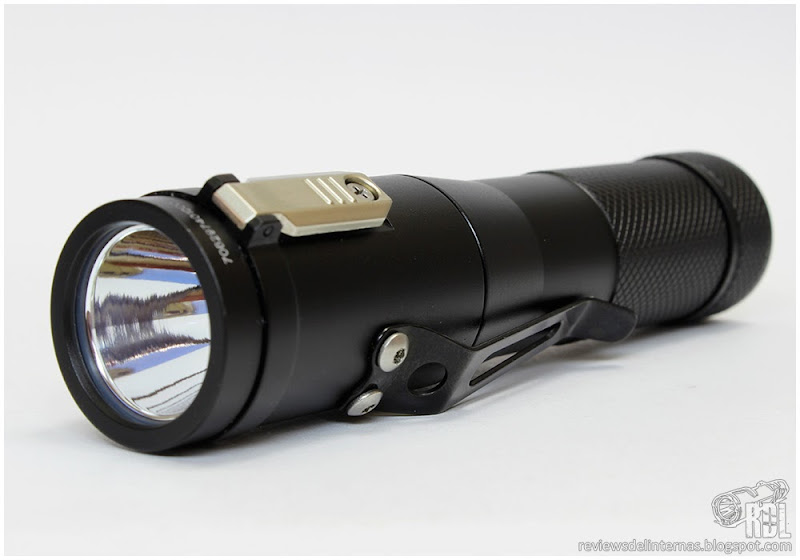
NITECORE CONCEPT 1
LED: CREE XHP35 HD CW
Battery: 1× 18650, 2x ®CR123a
Modes: 5 intensities, 3 stroboscopic modes
Switch: Digital, head.
Date: July 2017
INTRODUCTION
Nitecore has just released a new flashlight, this time something different to what we have been accustomed by this brand. The name of this new model already hints us a little about what type of flashlight we are about to know: Concept 1. As Nitecore describes, the Concept 1 is a simile to what in the automotive world is known like the designs of vehicles concept : Normally a daring design and ahead of its time in which the designers and engineers of the mark show the world a kind or technological goals that the brand has in mind.
Unlike in the automotive industry, where conceptual designs serve only for presentations and fairs, Nitecore has marketed Concept 1 so that end users have the opportunity to acquire a model on this novel and striking role.
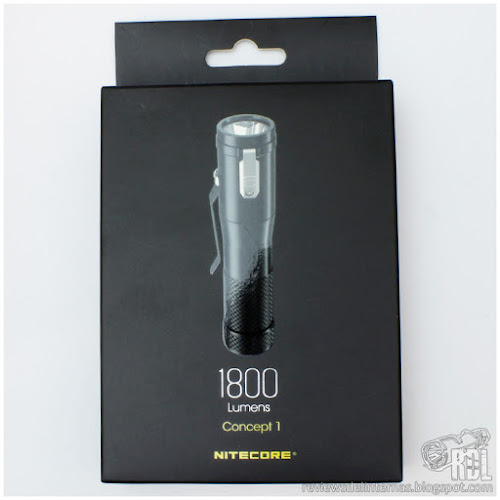
The flashlight box is different from the usual Nitecore packaging, and instead of following the strict color scheme of the brand, this time we find a completely black box in which an illustration of the flashlight presiding the center of the front , with the rest of texts and data minimalistic and very discreet.

In the interior we find a plastic tray with flashlight, a textile holster, paracord wrist strap, spare o-rings, and the usual documentation that accompanies all the products from this brand.
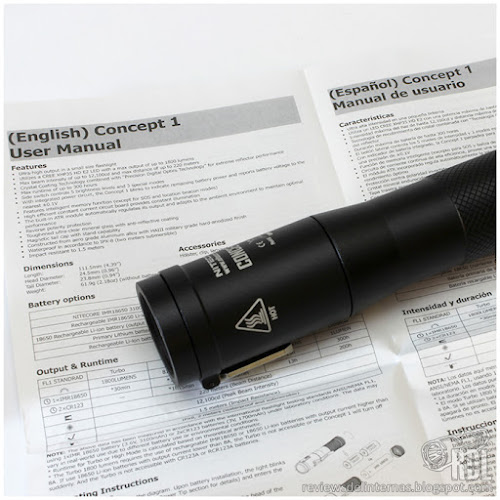
Note that recently Nitecore is translating their user manuals into several languages other than the usual two (Chinese and English) and we can now read it in Spanish.

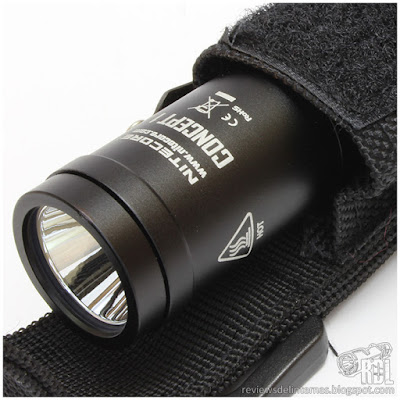
The included holster is the typical one that can be seen in other models of the brand. It also gives you the feeling thatit's a bit oversized. In this case, the holster has nothing conceptual.
EXTERNAL FINISH
The Concept 1 is a fairly original flashlight in its design. In general, its lines are simple and not complicated, and it is striking that given the figures that Nitecore announces, the flashlight does not have any type of dissipation fins or other body mechanized elements to multiply its surface in contact with the air.


The top has a smooth finish with a few engravings of logos on the head, and both the bottom cuarter and the tailcap have a not too aggressive knurling finish but providing enough grip when unscrewing.
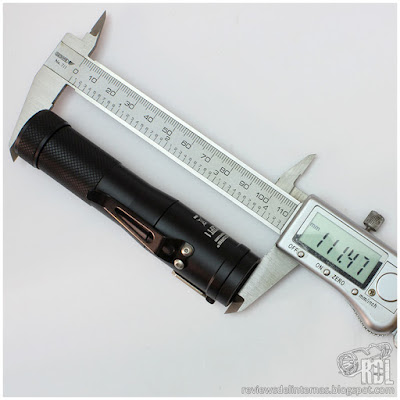
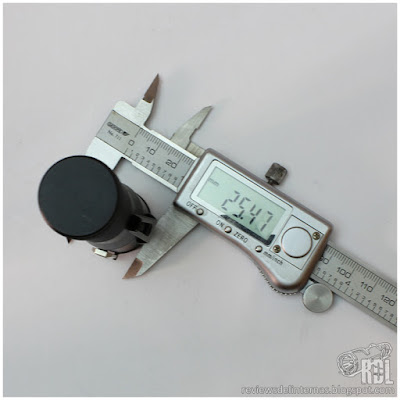
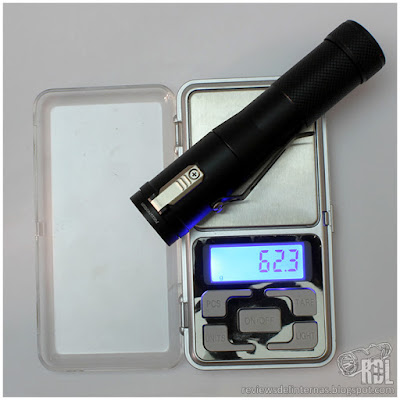

The dimensions are contained, although we are not on an ultra-compact flashlight such as DQG Tiny18650. With something more 110mm long and a diameter of 25mm in optics, and a battery-free weight of about 62g, the Concept 1 stays in simply compact.
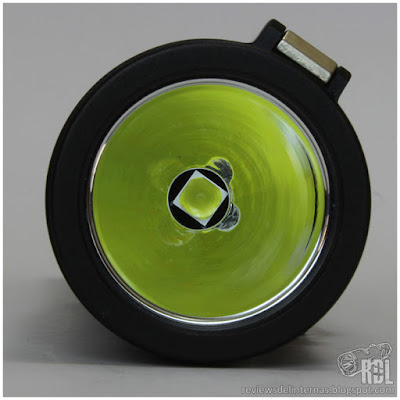

The optics is composed of a flat bezel, glass lens with AR treatment, smooth reflector with the XHP35 HD correctly centered. The overall finish of the optics, as is usual in this brand, impeccable.
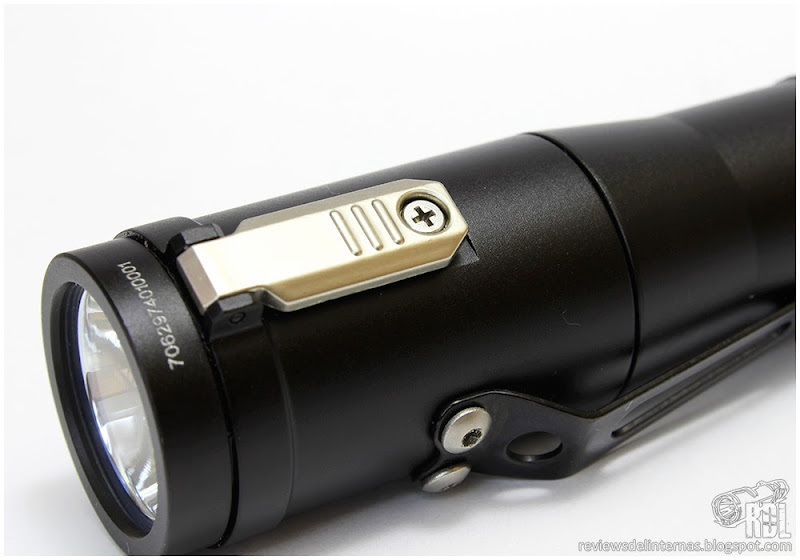
Next to the head we find something new. It is a switch concept something different from the typical silicone coating or metallic button.
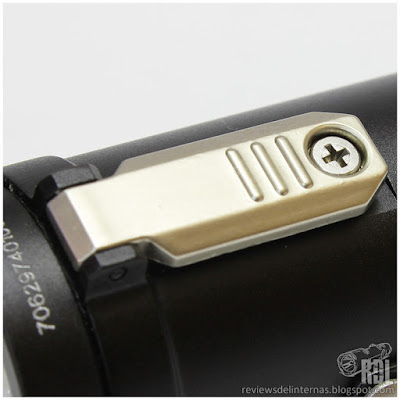
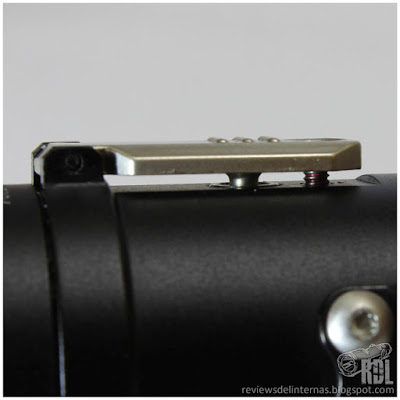
What Nitecore has implemented in the Concept 1 is a kind of side switch that, via a small-switch located at the bottom, acts on the light circuit. The button is made of metal, presumably stainless steel, and is fastened by a small phillips screw. As you may have imagined, this design makes accidental activations extremely easy if we carry the flashlight in a pocket. The switch also has some slack, transmitting a rattle when we put our finger on it.
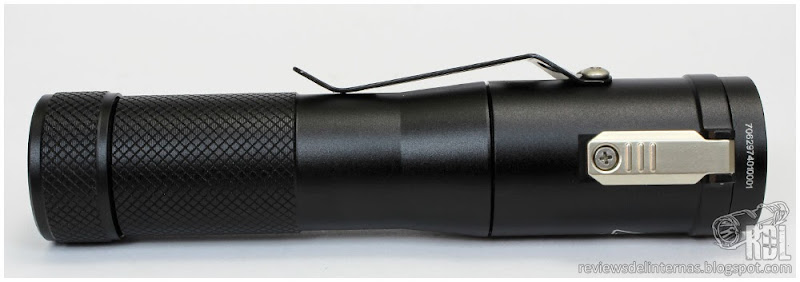
The clip is secured by screws to the head. The design of the clip is similar to what could be found in the old Nitecore EX11 / D11, only that instead of titanium the one which we find in Concept 1 is black lacquered steel.

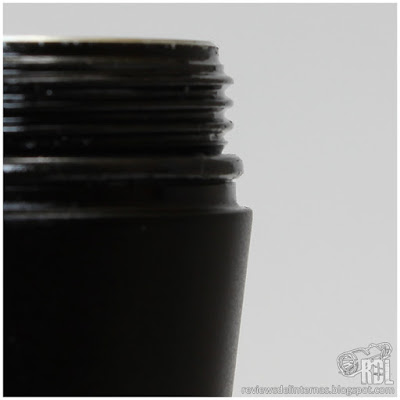
The flashlight can be disassembled into three parts. The loose head has a considerable weight, which denotes the use of high density metals in its internal construction. The contact for the positive pole protrudes over the profile, so we can use flat-top batteries without any problem. The threads have a standard triangular cut, are anodized and come clean and correctly greased.
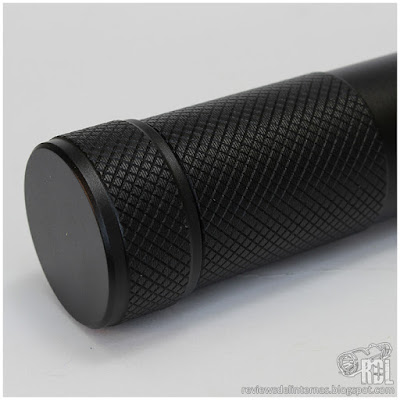
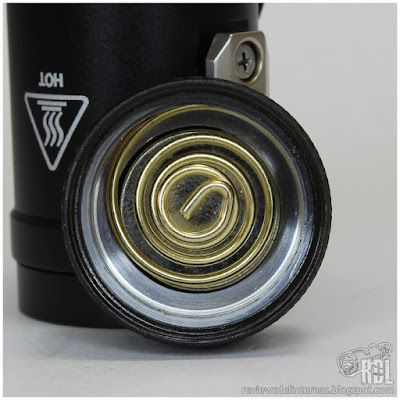
The tailcap has a completely flat base, allowing to place the light in tailstand in a stable way.
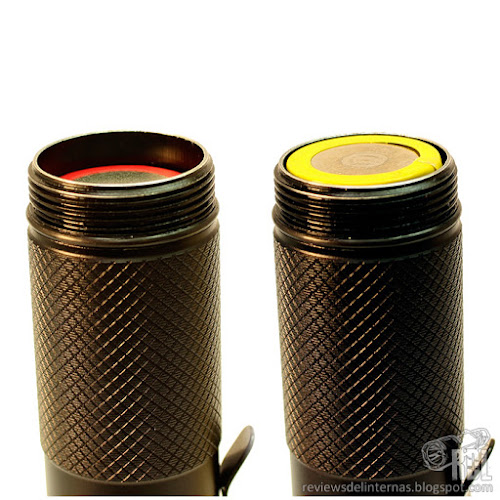
The space for the battery is generous, with sufficient housing to use protected 18650 batteries.

Underneath the spring located inside the tailcap there's a magnet that allows to fix the light to iron surfaces. I must say that the magnetic power of the magnet seems rather short, and it is convenient to make sure that the torch is securely sticked.
USER INTERFACE
The Nitecore Concept 1 has a fairly complete user interface, and with only one switch the handling and access to all modes and functions consists of different combinations and sequences.
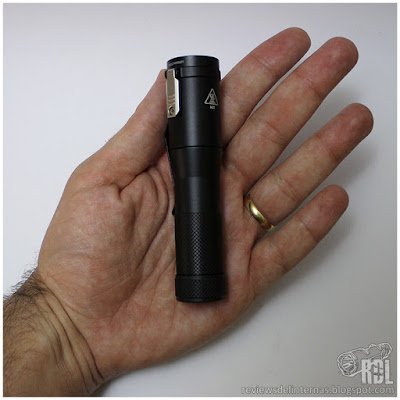
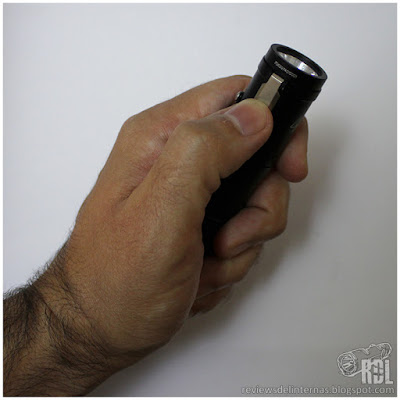
- Switching on and off: Holding the switch for approx. 0.5sec turns on the light. To turn it off, a single click does the trick.
- Mode groups: The Concept 1 has two groups of modes: General and Tactical. The difference between the two modes is that the General has direct access to the Turbo, while the Tactical has direct access to the strobe. To know in which way we are, we will slightly unscrew the tailcap and, with the switch pressed, we re-thread it: a flicker denotes that we are in General mode, two for Tactical mode. To select the other group simply repeat the operation.
- Changing modes: The mode selection must be done from the off, holding the switch pressed the flashlight will start to alternate between the five intensities upwards, with an interval of approximately 1 second in each mode. When you are in the desired mode, simply release the switch to enter that mode.
- Memory: The flashlight will remember our selection of last mode and in the next activation we will go direct to that mode. If we keep the switch pressed the alternating between modes will start from the one we have previously memorized.
- Direct access to Turbo / Strobe: As I said, depending on the group so that we find the flashlight will have direct access to the Turbo or strobe. To access these modes directly from standby is enough to perform a rapid triple tap. Similarly, with the flashlight on, simply hold the switch for momentary access to the Turbo, returning to the previous mode after releasing the switch.
- Direct access to Lower: From OFF state, a double click will activate the Nitecore Concept 1 straight in the Lower mode. (Thanks Firelight2!)
- Special modes: Strobe modes are hidden. To accede to them, it is enough to make a triple pulsation from on, acceding to the stroboscopic mode of variable frequency. If we hold the switch for approx. 0.5sec we will go to SOS mode, and if we repeat, we will go to beacon mode.
- Battery Voltage Reading: Each time we thigh any threads of the flashlight completely, the flashlight will read battery voltage, and will show us a sequence of flashes: ie: four flashes, followed by a pause and two Flashes more tell us that the battery is at 4.2V.
- Block-out: Unfortunately, the Concept 1 lacks an electronic lock to prevent accidental activation. However, having both threads anodized allows, with a slight unscrewing of either of the two, preventing the flashlight from turning on accidentally when, for example, we carry it in a pocket and at the same time eliminate any standby current always present in flashlights with An electronic switch. After my own measurements, I have noticed that the circuit of the Concept 1 requires a standby consumption of around 0.011mA, a fairly low current.

The distribution of intensities is, in my opinion, fairly well spaced. The lowest mode offers little more than one lumen. The Low and Mid modes are very well located, with consistent intensities for everyday use. The High mode is practically the higher mode that we would find in any compact 18650 … and we have the Turbo which, depening on the battery we are using, offers a really impressive output for the size of flashlight. There is no presence of PWM in modes, all appear to be achieved by regulated current.
PERFORMANCE
This new family of high-output LED emitters needs, as it could not be otherwise, batteries capable of delivering steady high currents. That is why Nitecore recommends the use of an IMR battery or, failing that, one that is capable of delivering a constant discharge of 6 amps. In my case, I have tested the flashlight with several batteries and I have been able to see how with the typical protected batteries the flashlight is unable to reach the Turbo mode, and either shut off by the battery circuit or automatically go back to the low mode.

For the usual test in the mode of maximum performance I have used an IMR18650 of those Nitecore markets for its TM28, and to check the difference I have repeated the test with a common NCR18650A. You can see how the discharge curve is quite different between both batteries: The IMR offers a much higher initial output, and seems to maintain a constant struggle for not lowering a mode, while the Panasonic three minutes after activation is no longer able to supply the necessary power and seems to stabilize at an intensity around 730lm. The difference in behavior between the two batteries is probably because the IMR is the thermal management that decides the maximum output of the flashlight, while with the NCR18650A is decided by the voltage of the battery.
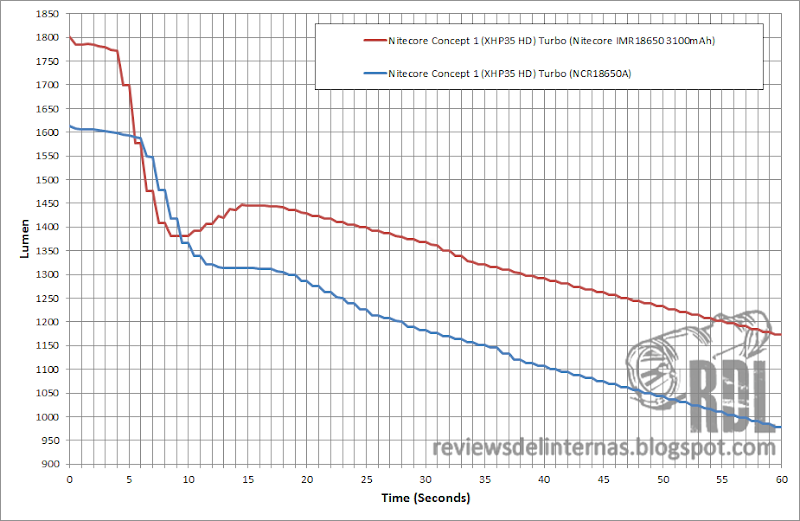
In this zoom view (at the maximum resolution that my measurement and data-logging instrument allows me) we can observe the behavior of both batteries during the first minute of continuous use. Both curves show a curious little bump around the seventh second, that the IMR seems to try to overcome it. Curious…
Firelight2 wrote:
… If you press and hold the button down while it is dimming it will instantly revert back to max turbo. However, if you do this a lot it gets burning hot.
I just did a quick test to see how the Turbo with switch pressed affects to the performance of the flashlight:… If you press and hold the button down while it is dimming it will instantly revert back to max turbo. However, if you do this a lot it gets burning hot.


As you can see, I've tested the Concept 1 while continuously holding pressed the switch after a shortcut-access to Turbo mode. I also tested the light with a INR18650-30Q and obtained better initial output and overal performance than with the Nitecore IMR18650 "for TM28" battery.
The stepdown must be (unconfirmed) by temperature. At the moment the light dropped the output it was really unconfortable to hold on the hand.

Compared to other high-performance compact flashlights, the Concept 1 seems to benefit from the extra efficiency its XHP35 offers versus the classic XM-L2 or XP-L.
BEAM PROFILE
The projection is quite common, very similar to what we will find in most compact single-LED flashlights.




We have a clearly flooding profile, but thanks to the use of a smooth reflector and the perfect centering of the LED emitter, the Concept 1 has a well-defined hotspot and, according to manufacturer, has a maximum throw of 220 meters ANSI.

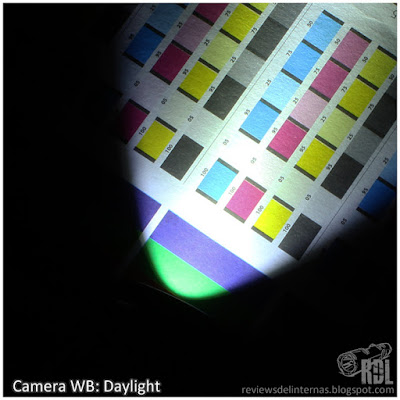
The tint is cold white with a slight tendency to greenish, especially visible in the corona that surrounds the hotspot. This type of chromatic distortion has already become common for flashlights using the latest CREE emitters.
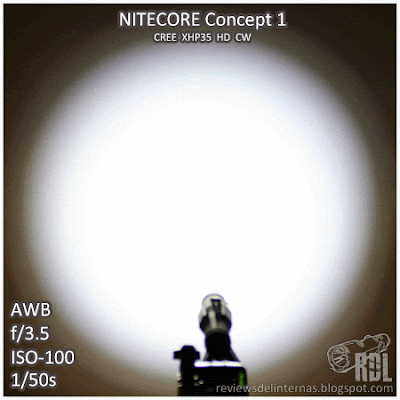
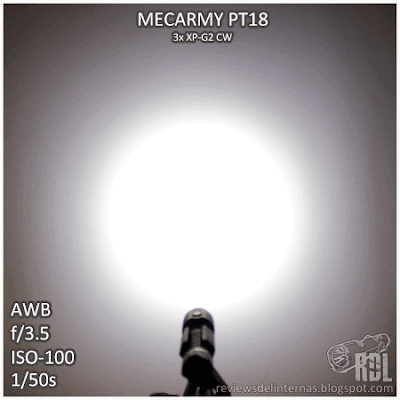


PERSONAL CONCLUSION
This Concept 1 has left me a bit with mixed feelings. On the one hand, I expected a more compact flashlight and perhaps something more innovative, but on the other I didn't expected these levels of efficiency at such high output as I have been able to verify.
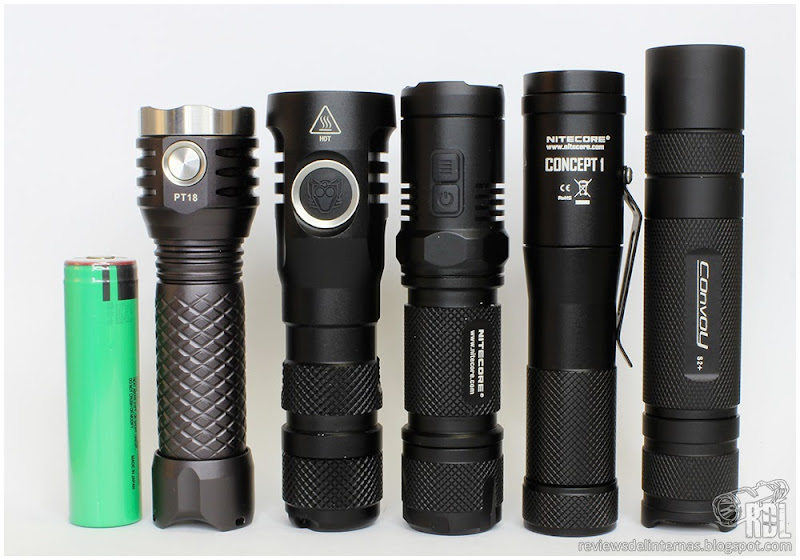

MecArmy PT18 · Manker U11 · Nitecore EC21 · Nitecore Concept 1 · Convoy S2Plus
Negatives: The switch is, in my opinion, is a bit of nosense. Besides not contributing anything (beyond a "futuristic" aesthetic), it makes the flashlight extremely easy to be accidentally activated. We are talking about a flashlight that momentarily emits real 1800lm, which with the view adapted to the darkness can give us a good disgust. The user interface lacks an electronic block-out, which would be very useful. I also do not like having to turn off the flashlight to change a mode, and it is not the first flashlight I have seen in recent times that needs this type of combination to go from, say, low to medium. On the other hand, the magnet in the tailcap is rather flimsy, and by placing the flashlight parallel to the ground, there is a good chance that the flashlight will "slip" down, even dropping. On the other hand, I think the conceptual design, beyond the aforementioned switch design, has very little, and I expected a more compact flashlight than what I've found. Even the Nitecore EC21 (from 2014) is shorter, and has a double switch more or less in the same place as this Concept 1.
Positive aspects: The first thing that caught my attention when turning on this flashlight in Turbo mode was, besides than the amount of light emitted, how quickly the head rises in temperature. By disassembling and holding only the head one can already intuit how Nitecore has used high density metals in the interior design, able to better tolerate the high temperature that the XHP35 generates when we give it the according current. Thermal management is a good alternative to time-controlled, and will allow greater output if environmental conditions allows. The mechanical finish of the flashlight is impeccable, as well as the anodizing and well-defined engravings. The spacing of the modes is very well achieved. The voltage reading function seems to me a much more useful solution than the mere indication of state with 4, 3, 2 or 1 flashes. The possibility of choosing between a direct access to the strobe or the turbo is very well brought.
Nitecore Concept 1 sample provided by Nitecore for test & review
Last edited:


